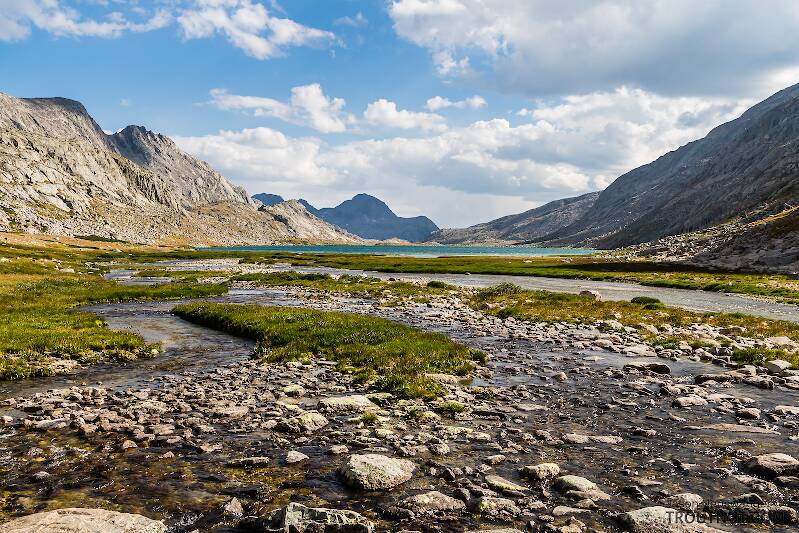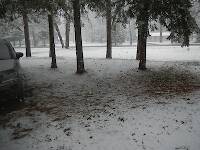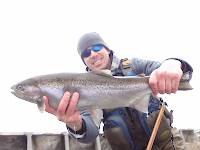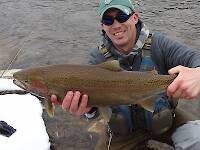
Salmonflies
Pteronarcys californica
The giant Salmonflies of the Western mountains are legendary for their proclivity to elicit consistent dry-fly action and ferocious strikes.
Featured on the forum

This dun emerged from a mature nymph on my desk. Unfortunately its wings didn't perfectly dry out.

Troutnut is a project started in 2003 by salmonid ecologist Jason "Troutnut" Neuswanger to help anglers and
fly tyers unabashedly embrace the entomological side of the sport. Learn more about Troutnut or
support the project for an enhanced experience here.
Report at a Glance
| General Region | N Colorado |
Details and Discussion
PaulRoberts on Apr 7, 2011April 7th, 2011, 10:18 am EDT
April 6, 2011
A little fishing while my son takes his voice/piano lesson. I could just hear the wavering high notes of his rendition of “Where is Love” emanating from the streamside cabin as I took the path down to the little creek below.
Overcast, snow due in tonight; An icing fog on mountains above, very light misty rain/heavy mist below. Tricaudatus weather! A little late in the afternoon I suppose, but the hours-old memory of those little duns should be enough to interest some trout.
It’s a fast turbulent stretch of pocket water here, not the place I’d choose if I were just fishing. But begger's, and dedicated Dad's, can't be choosers. I spotted a trout right away in the eddy of a cut, up off bottom in active position. “Looks like a spring trout to me”, I thought. “Water’s gotta be cold though.” Id’ve guessed 45 by season and conditions in this stretch (being as out-of-touch as I currently am), but upon seeing that active trout I thought, “Maybe upper 40s?” “Can’t be 50…” -especially with the frost on the trees on the mountains above and the very last remnants of snow in the canyon shadows.
I took a water temperature: 38F! I had a #18 tricaudatus Comparadun tied on. Guess I’m a tad early this year, this far up anyway. Was only playing, killing three-quarters of an hour, so I decided to fish the dry, just to fish a dry after a long winter of tying them. I plied the first cut finding only one decent laminar slick to work, and an entire trout head rose to meet my dun! Pop! And I wrestled in a pretty copper backed, red sided, amber flanked ‘bow. “You are ready to rock I see,” I said out loud as I dug the hook from deep along the inside of its lower jaw; a long snouted male somewhere in the 10inch class; A good average mature trout for this section of this stream.
The next cut yielded a trout nose –a half attempt, or refusal, I couldn’t tell. It wouldn’t come again. A refusal, I thought. “It’s really midges you were expecting, eh?” Two midge varieties were in the air: a #42 WC (“Who Cares”), and a #24 LGB (“Little Gray Bastard”) now dipping to deposit eggs.
The next cut was the one I’d seen the active trout in, and I now knew why: That it was indeed spring, despite the “winter” water temps. I’d marked the rectangular rock below the VW-sized boulder the trout had been holding beside. With the 7ft rod I was using I had to creep all the way to the tail lip, closer than I could have got away with had the sun been higher, and the sky brighter, and I sat on a partially submerged boulder. It was late afternoon, under a deep overcast, in a deep canyon, and the trout rose about 8ft from my rod tip. But it had moved from my mark, into a dead calm pocket about the size of a basketball hoop, surrounded by boiling, seething, dense/viscous, line gobbling turbulence. And I could not get a drift there. I dared not get closer. So, I waited and watched it rise aggressively (for such cold water) pushing the syrup-like water and making a good “smock!” with each rise. Then the pocket was quiet. I pitched back to the rectangular rock and she was there –another 10+inches of copper, red, and amber. I got back to the cabin just in time to hear my son's final refrain, “Where-ere-ere-ere-ere iiissssss llllooooovvvvvvve!”
So there it is. It’s spring! So say the trout –at least the ‘bows in this stretch. I kinda doubt the browns would have been as willing, and I didn’t see any despite the fact that they tend to outnumber the bows in this stream –at least in the warmer months. Mebbe it was the faster turbulent water in this stretch, keeping the browns at bay. But, 38F is mighty cold for dry fly fishing for any species. Everyone is hopeful in April apparently.
A little fishing while my son takes his voice/piano lesson. I could just hear the wavering high notes of his rendition of “Where is Love” emanating from the streamside cabin as I took the path down to the little creek below.
Overcast, snow due in tonight; An icing fog on mountains above, very light misty rain/heavy mist below. Tricaudatus weather! A little late in the afternoon I suppose, but the hours-old memory of those little duns should be enough to interest some trout.
It’s a fast turbulent stretch of pocket water here, not the place I’d choose if I were just fishing. But begger's, and dedicated Dad's, can't be choosers. I spotted a trout right away in the eddy of a cut, up off bottom in active position. “Looks like a spring trout to me”, I thought. “Water’s gotta be cold though.” Id’ve guessed 45 by season and conditions in this stretch (being as out-of-touch as I currently am), but upon seeing that active trout I thought, “Maybe upper 40s?” “Can’t be 50…” -especially with the frost on the trees on the mountains above and the very last remnants of snow in the canyon shadows.
I took a water temperature: 38F! I had a #18 tricaudatus Comparadun tied on. Guess I’m a tad early this year, this far up anyway. Was only playing, killing three-quarters of an hour, so I decided to fish the dry, just to fish a dry after a long winter of tying them. I plied the first cut finding only one decent laminar slick to work, and an entire trout head rose to meet my dun! Pop! And I wrestled in a pretty copper backed, red sided, amber flanked ‘bow. “You are ready to rock I see,” I said out loud as I dug the hook from deep along the inside of its lower jaw; a long snouted male somewhere in the 10inch class; A good average mature trout for this section of this stream.
The next cut yielded a trout nose –a half attempt, or refusal, I couldn’t tell. It wouldn’t come again. A refusal, I thought. “It’s really midges you were expecting, eh?” Two midge varieties were in the air: a #42 WC (“Who Cares”), and a #24 LGB (“Little Gray Bastard”) now dipping to deposit eggs.
The next cut was the one I’d seen the active trout in, and I now knew why: That it was indeed spring, despite the “winter” water temps. I’d marked the rectangular rock below the VW-sized boulder the trout had been holding beside. With the 7ft rod I was using I had to creep all the way to the tail lip, closer than I could have got away with had the sun been higher, and the sky brighter, and I sat on a partially submerged boulder. It was late afternoon, under a deep overcast, in a deep canyon, and the trout rose about 8ft from my rod tip. But it had moved from my mark, into a dead calm pocket about the size of a basketball hoop, surrounded by boiling, seething, dense/viscous, line gobbling turbulence. And I could not get a drift there. I dared not get closer. So, I waited and watched it rise aggressively (for such cold water) pushing the syrup-like water and making a good “smock!” with each rise. Then the pocket was quiet. I pitched back to the rectangular rock and she was there –another 10+inches of copper, red, and amber. I got back to the cabin just in time to hear my son's final refrain, “Where-ere-ere-ere-ere iiissssss llllooooovvvvvvve!”
So there it is. It’s spring! So say the trout –at least the ‘bows in this stretch. I kinda doubt the browns would have been as willing, and I didn’t see any despite the fact that they tend to outnumber the bows in this stream –at least in the warmer months. Mebbe it was the faster turbulent water in this stretch, keeping the browns at bay. But, 38F is mighty cold for dry fly fishing for any species. Everyone is hopeful in April apparently.
Quick Reply
Related Discussions
Topic
Replies
Last Reply
5
Mar 12, 2012
by Pryal74
by Pryal74
5
Mar 6, 2016
by PaulRoberts
by PaulRoberts





